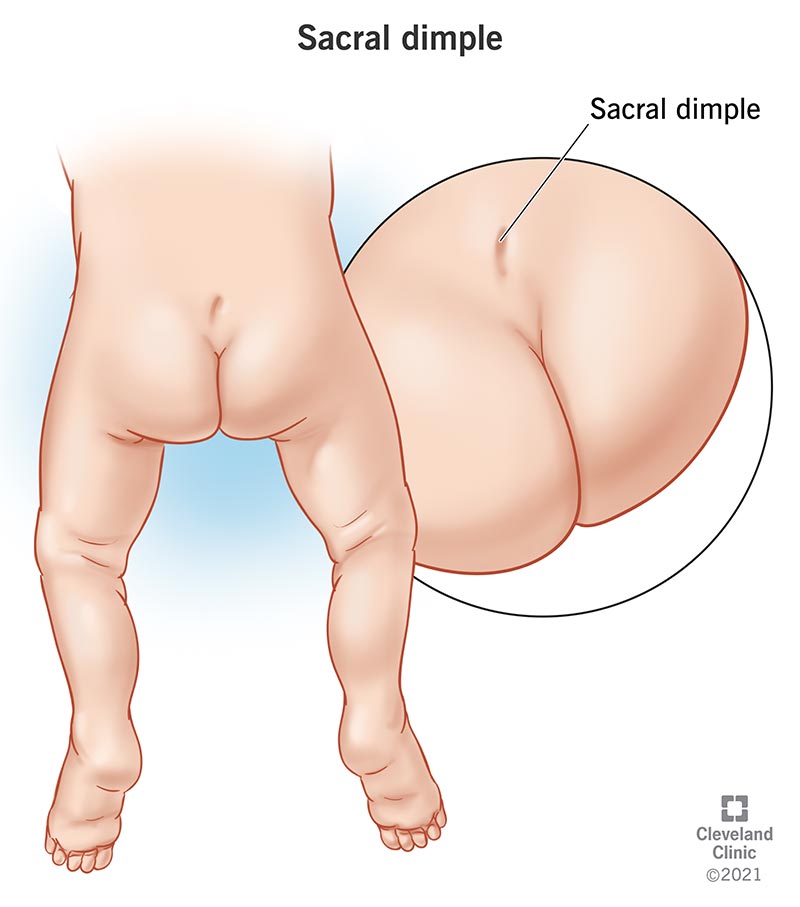A sacral dimple is a small dent on your baby’s lower back. Most sacral dimples are harmless and don’t need treatment. But in rare cases, they can signal spinal issues. Your baby’s healthcare provider will check its size, location and related signs to decide if it needs testing. Knowing when to seek care can help you feel more confident.
Advertisement
Cleveland Clinic is a non-profit academic medical center. Advertising on our site helps support our mission. We do not endorse non-Cleveland Clinic products or services. Policy

A sacral dimple is a small indentation in your newborn’s lower back near the crease of their butt. “Sacral” means it’s located at your baby’s sacrum. Your baby’s sacrum is the bone at the bottom of their spine. Sacral dimples are congenital. That means your baby is born with it. Most of the time, a dimple on your baby’s sacrum won’t cause any issues. It won’t go away, but as your child grows, it should become less noticeable.
Advertisement
Cleveland Clinic is a non-profit academic medical center. Advertising on our site helps support our mission. We do not endorse non-Cleveland Clinic products or services. Policy
Sometimes, a sacral dimple can be a sign of an underlying spinal issue. These can include neural tube defects, like:
If your baby has a sacral dimple after birth, their healthcare provider will look closely. Based on its size and location, they may order more tests to rule out any spinal problems.
About 2% to 4% of babies are born with a dimple on the sacrum.
Back dimples are also congenital indentations found on your baby’s lower back. But they come in a set of two — one on each side of your baby’s spine. Tissues called ligaments create these dimples on their back. Ligaments connect your baby’s skin to their pelvic bones. Like sacral dimples, back dimples are usually harmless.
They’re sometimes called Dimples of Venus, after the Roman goddess of beauty. In mythology and folklore, these dimples were thought to symbolize beauty, luck and even fertility — though there’s no scientific evidence to support those beliefs.
Advertisement
Pilonidal dimples are also found at your baby’s lower back. But they aren’t congenital — they develop after birth. These dimples are small pits that can be shallow or deep. They may also contain hair.
In a small pit, body hair and sweat can create the perfect environment for an infection. If a pilonidal dimple becomes infected, a pilonidal cyst may form. A pilonidal cyst is a round sac of tissue filled with fluid or air. It can become swollen and painful, and it may form a pocket of pus (abscess) if left untreated.
Sacral dimples don’t have any symptoms other than the indentation itself. The dimple is typically shallow and found in or near the crease of your baby’s butt.
In rare instances, a dimple on your baby’s sacrum can be a sign of a spine or spinal cord problem. In these cases, your baby’s healthcare provider may refer you to a specialist for further testing.
Researchers don’t know why sacral dimples develop in some babies and not others. Some believe dimples may be genetic. But since they’re usually harmless, scientists haven’t done a lot of research on them. If the dimples are genetic, they’re not sure which genes cause them.
If your newborn has a dimple at their sacrum, their provider may take a closer look. They’ll typically make the diagnosis during this exam. They’ll note its size and location. They may also order an ultrasound if they notice anything that may signal an issue.
Most sacral dimples don’t cause any problems or need any treatment. If the sacral dimple is a sign of an underlying issue, your baby’s healthcare provider will refer you to a specialist.
You might be wondering when to worry about a sacral dimple. Your baby’s healthcare provider will likely notice any concerning symptoms right after birth. But contact their provider if:
Most babies with sacral dimples don’t have any symptoms or complications that need treatment. A dimple on the sacrum may stay with them for life. But they probably won’t notice it. If they do, it just becomes a part of who they are.
A sacral dimple can be surprising when you first notice it. But most of the time, it’s simply another small detail that makes your baby unique. Knowing what to look out for and when to check in with your baby’s healthcare provider can give you peace of mind. If questions or worries come up, you don’t have to have all the answers right away. Your baby’s care team is there to help you.
Advertisement
As your child grows, you need healthcare providers by your side to guide you through each step. Cleveland Clinic Children’s is there with care you can trust.

Last reviewed on 11/05/2025.
Learn more about the Health Library and our editorial process.